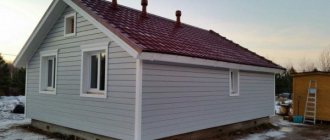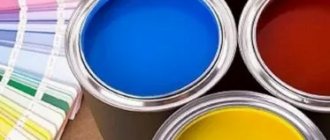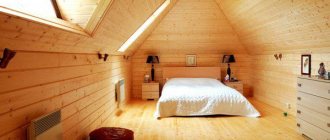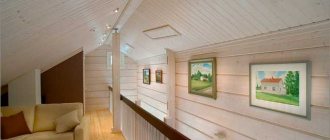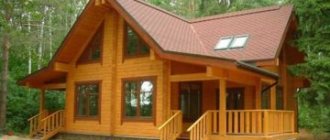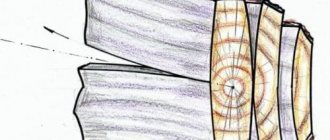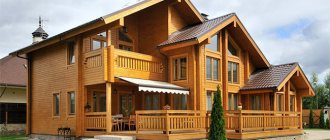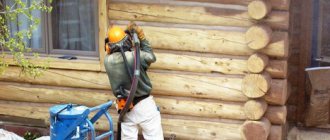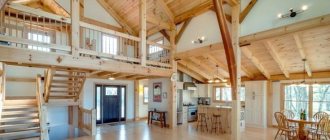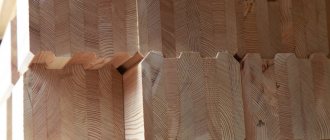Nowadays it is quite difficult to imagine houses without cladding. A wide variety of materials are used for facade finishing, including imitation timber. These products require some care and painting.
Considering that the facade made of imitation timber will have to be painted in any case, every homeowner is faced with the question of choosing the appropriate material, as well as the technology for carrying out the work.
In this article we will look at how to treat and paint wood cladding on the outside of a house.
Why paint imitation timber?
The answer to this question is on the surface, because imitation timber is one of the types of wood material for cladding the facade. Wood needs certain measures aimed at ensuring long service life, reliability and strength. Any wood material without additional measures is subject to cracking, shrinkage, drying out, rotting, and damage by insects and rodents.
To avoid any problems with wood, it is necessary to treat the cladding material using both special preparations and paints and varnishes . All compositions are capable of providing the necessary level of protection of the material from adverse factors that destroy it. It is necessary to treat the surface of a facade covered with imitation timber not only to achieve reliability and protect it from destruction, but also to maintain the attractive appearance of the entire wooden surface.
If we are talking not only about purchased material, but about the surface that has been on the building for many years, then painting may also be necessary due to loss of aesthetic appearance. A certain type of paint is used in cases where stains form on the surface of the facade, or the entire surface has darkened and lost its original appearance.
Sanding walls made of timber: independent work and recommendations
Sanding timber.
What it is? What is it for? Is it necessary to sand the timber? Many people face this issue. First, I would like to put everything into perspective and give reasons why it is worth sanding a home made of timber. Before painting, you can notice various defects that arose after the timber shrinked. In such a situation, it is necessary to carry out grinding: it will not only help eliminate defects, but can also help align the internal walls. Over time, a timber building may fade and lose its visual appeal. To prevent this from happening and the wood to retain its beautiful appearance, you just need to sand it. Naturally, it is possible to do the interior decoration, but in this case the texture of the wood nature will be blocked and the reason why you built the house from timber will disappear.
Grinding is an uninteresting and thorough job, which is why the cost of grinding among experts is expensive, from two hundred and fifty to three hundred and fifty rubles per square meter.
Types of paints
It is necessary to choose a specific type of paint and varnish product based on several factors:
- degree of resistance to atmospheric conditions and mechanical influences;
- guaranteed service life;
- vapor permeability level.
Otherwise, you can focus on taste preferences regarding color (or lack thereof). It is important to pay attention to the climatic conditions in the region where the house is located.
Opaque formulations
Preference is given to this type of composition if there is no desire to preserve the natural texture of the wood . Each type of paint and varnish material has a characteristic color; it is possible to choose the one most suitable for the overall design of the building. Of the entire available range of paints containing color pigments, the following varieties are distinguished:
- oil. Despite the fact that the compositions are considered the most affordable, their quality does not always reach the desired level . They are characterized by a low level of resistance to the relative influence of UV rays. For finishing work on the facade, it is very expensive to use such paint, since it requires re-processing after two to three years, otherwise the imitation timber will begin to fade and form cracks. These paints are also distinguished by the longest period required for the composition to dry and an unpleasant odor that appears only after several days;
- alkyd. They are considered the most modern products. They have a very large selection of colors and the highest level of protective functions . The duration of preservation of color in its original form is long. As for their processing of imitation timber on the facade, they are not very reliable.
- acrylic. This variety has proven itself to be ideal for woodworking. Their range is varied and allows you to choose the option that suits you best. This type of paint is characterized by practicality and durability in comparison with other types of paint. A separate advantage is the absence of pungent odors when working with the composition. The level of adhesion of simulated timber surfaces with paint is very high. Regarding the disadvantage, there is only one – the cost of materials is slightly higher than the previous ones.
Transparent compounds
There is a term for this type of paint - glaze. These compositions are distinguished by their ability to emphasize and accentuate the natural beauty of wood, highlighting their texture. The only thing worth considering when choosing a transparent type of paint is the presence of defects, cracking or dark inclusions on the surface of the imitation timber. They will not disappear after treatment with the composition.
The following types of transparent compositions are distinguished:
- water-based compositions . They are considered the safest and most convenient to use; the main component is water;
- polymer type varnishes. Polyurethane-based materials are mainly used for external processing of imitation timber. They are characterized by the highest level of strength and wear resistance. The price of such materials is slightly higher than the previous ones;
- impregnation _ The most common of this type of transparent paint is drying oil. Despite its ease of use and good protective properties, there are the most modern compositions that have better performance characteristics;
- glaze _ Such compositions are used not only to provide protective functions to the tree, but also to give it a lighter or darker tone as needed. Wood is painted with it if there is a desire to create a “antique” effect.
Required materials and tools
Before you start painting your house, prepare all the tools you may need in advance. This will allow you not to be distracted while searching for the right item.
- Protective work clothing, rubber gloves, safety glasses;
- brush, roller, spray bottle;
- container for liquids (primers, drying oils, impregnations, paints and varnishes);
- sandpaper or angle grinder (angle grinder) with a replaceable disc for grinding;
- consumables (antiseptic, primer, paint and varnish);
- stepladder, scaffolding or sawhorse;
- paper (masking) tape.
If you plan to paint your house with a spray gun, you will need electricity to connect it. Also, electric current will be needed to turn on the angle grinder.
Manufacturing companies
You can purchase a high-quality composition not only based on the above parameters, but also by paying attention to the most popular and proven quality manufacturing companies.
The most common are:
- Zobel, made in Germany. The range includes water-based paints and varnishes;
- Osmo, made in Germany;
- Tikkurila, a Finnish company;
- Termica, domestic manufacturer;
- Finncolor, made in Russia.
Should I apply varnish after paint?
In order not to get confused in the technology of processing imitation timber, you need to understand that the main material for such work is either paint or varnish. There is no need to treat with both compositions.
A layer of paint will provide all the necessary protective functions and give the surface the desired color (without using varnish on top of such a layer). If you do not want to paint the wood in any specific color, then it is better to use varnish and preserve the natural beauty of the material.
Basic mistakes
If a person sands walls for the first time, he may make certain mistakes, as a result of which the quality of the work is significantly reduced:
Many home craftsmen, when performing grinding on their own, often make mistakes, among which the most common are:
Sanding is a complex and time-consuming job that requires a lot of patience and a competent approach. It’s not easy to do it yourself, without certain skills and experience.
Source
Surface preparation
To achieve a high-quality result that will last for many years, the surface of the imitation timber must be prepared; for this, use the following recommendations:
- It is better to start work when the temperature reaches + 5 degrees Celsius;
- to ensure improved adhesion of the paint composition to wood, it is sanded and sanded;
- Next, it is recommended to prime the surface and wait for it to dry completely.
NOTE!
We should not forget about cleaning the surface, since dust particles accumulated after sanding and grinding interfere with the quality of the work. It is recommended to use a vacuum cleaner to remove dust.
At the surface preparation stage, you can use an iron brush and use it to treat the entire surface. This will ensure the deepest penetration of the composition into the wood material. In other words, this surface preparation technique is called brushing. It enhances the natural texture pattern, and the method is also suitable for giving wood an antique look.
Abrasive sandblasting
When assembling industrially manufactured house kits, suppliers grind the outside of the timber using sandblasting or abrasive blasting. You can order such processing for the log house of your house from specialized companies. The technology allows you to quickly and efficiently process the surface, inter-crown cracks, locks and corners of the log house. Compared to electromechanical tools, productivity increases four times.
It is not recommended to use sandblasting for sanding timber inside the house.
When abrasive jet sanding, a brushing effect appears, the wood pattern on the surface is effectively highlighted, emphasizing its attractiveness.
Surface painting
To carry out this stage of work, you can use either a roller, a brush, or a spray gun . It is still recommended to choose a brush, since it ensures the most thorough painting of the entire surface.
Paint begins to be applied only after measures have been taken to treat the wood façade with antiseptic preparations. It is also recommended to use protective compounds after antiseptics that protect the tree from the negative effects of ultraviolet radiation, such as Pinotex.
Otherwise, adhere to the following recommendations:
- It is important to dilute the paint only in accordance with the instructions in the instructions;
- to prepare the composition, you must use only a clean container;
- You should first prepare all the necessary tools for work;
- After this, apply the coating, maintaining the thinnest possible layer;
- it is necessary to paint the surface as thoroughly as possible;
- after the first or also called the base layer has completely dried, begin applying the second;
- Regarding work on the facade, painting it requires 3 to 5 layers.
NOTE!
It is recommended to paint the imitation timber before covering the façade of the house with it. This will allow the coloring composition to be distributed as evenly as possible and allow the product to dry completely.
Conclusion
This work cannot be delayed; experts recommend doing it immediately after installing the roof, since over time the wood hardens and sanding it will be much more difficult.
If you follow all the recommendations of experts, work slowly and carefully, you will be able to make your timber walls smooth and beautiful on your own.
Sanding will be successful if you follow all the recommendations step by step, do not rush, and work in the right direction (see also the article Installation of a house made of timber: from foundation to painting). And the video in this article will provide visual information on this topic, watch it!
Applying varnish
Varnish, like paint, is recommended to be applied only after the imitation timber has been treated with an antiseptic and a composition that provides ultraviolet protection. The process of applying varnish is not much different from painting a surface.
It is necessary to apply the varnish coating in two or three layers, waiting until the previous one has completely dried . It is also worth remembering that the varnish must be applied only using a brush.
IMPORTANT!
If you choose yacht varnish to process imitation timber, then there is no need to use any additional impregnations or antiseptics. This type of varnish is self-sufficient and provides all the necessary protective and decorative properties at a high level.
Factory painted boards
In addition to the fact that it is possible to paint imitation timber, you can independently give it the desired texture and color. There is an opportunity to purchase ready-made products; you certainly won’t have to doubt the quality.
The production dyeing technology at the factory involves processing the product from all edges. Such a process cannot be carried out independently if the façade has already been finished with imitation timber.
During production painting, grinding is carried out on a machine . This is necessary to eliminate any error that cannot be avoided by hand-dying the products. A certain composition thickness parameter is observed, equal to 40-60 microns.
By applying paint or varnish manually, this parameter is very difficult to achieve, but it is quite important . If the paint is thinner than the specified parameter, it will not last for a long time. If you apply a layer more than permissible, this threatens the loss of elasticity, which is characteristic of wood material.
The colors and textures of the products are very diverse. In the process of industrial painting, imitation timber is given any colors that imitate various tree species, for example, pine, spruce, larch, alder, oak and others. The same goes for texture. Products are available for sale in white, black, dark brown, and red colors.
Peculiarities
Despite the high-quality professional assembly of a wooden building, individual rows of beams in the structure can protrude by 1-2 mm, making the walls uneven. To achieve ideal smoothness of the walls inside the house, it is necessary to grind the timber, although such work also has other purposes.
This process solves several problems:
Polishing also involves the removal of a layer damaged as a result of external influences, renewal after several years of operation of the room. In addition, this removes old varnish and antiseptic impregnation from the surface, which are no longer relevant. Sanding helps restore the timber to the look and color of fresh wood.
